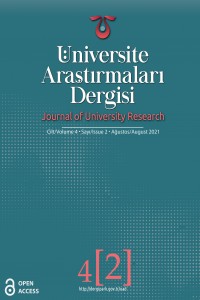Abstract
Purpose: Today, the phenomenon of globalization that directly affects the developments in the world is changing and transforming Higher Education. Internationalization in higher education is one of the critical areas that many countries take into account and develop policies. Increasing the number of international students makes a wide range of contributions to countries. Economic, social, political, academic, and cultural policies are the main factors affecting student mobility. In this study, it is aimed to evaluate the effect of the Turquality program on international student mobility.
Design/methodology/approach: In the study, data on international student mobility were evaluated.
Findings: The United States and the United Kingdom, where the higher education system is highly developed, have the highest share in this area, with the contribution of their native language being English. However, the recent anti-globalization developments in these countries have led to a change in the trend of international student mobility, enabling other countries to gain new opportunities. Turkey, with the effect of instability in the hinterland of the country, has achieved a significant rise in the number of international students in recent years.
Discussion: In this study, international student mobility that increases with globalization is analyzed; Turkey’s policy in this area and the opportunities provided by the Turquality project to the Higher Education sector are discussed.
Keywords
References
- Akin, M. A. (2018). Nation Marking as a Tool for Public Diplomacy: The Case of Turquality. Istanbul: Maltepe University.
- Altbach, P. G. (1998). Comparative Higher Education: Knowledge of the University, and Development. Comparative
- Education Research Center, The University of Hong Kong.
- Arkalı Olcay, G., & Nasır, V. (2016). Internationalization of Higher Education: Top Student Perspective Overview of Area Countries and Turkey from 99-13 years. Journal of Higher Education and Science, 288-296.
- Atlas, P. (2019, Ağustos 1). Research and Insights. Retrieved from INSTITUTE OF INTERNATIONAL EDUCATION: https://www.iie.org/en/Research-and-Insights/Project-Atlas/Explore-Data/Current-Infographics
- De Wit, H., & Adams, T. (2010). Global competition in higher education: A comparative study of policies, rationales, and practices in Australia and Europe. In Higher education, policy, and the global competition phenomenon (pp. 219-233). New York: Palgrave Macmillan.
- Deniz, E. (2010). Branding and Advertising . İstanbul: Kum Saati Publications.
- Knight, J. (1994). Internationalization: Elements and Checkpoints. Ottawa: Canadian Bureau for International Education (CBIE).
- Nardalı, S., & Tanyeri, M. (2011). Branding in Higher Education. Journal of Faculty of Business, Volume 12, Number 2, 309-319.
- OECD. (2017). Education at a Glance 2017: OECD Indicators. Paris: OECD Publishing. Özer, M. Last Fifteen Years of Higher Education Internationalization in Turkey. Journal of Higher Education and Science, 177-184.
- Özoğlu, M., Gur, B. S., & Coşkun, İ. (2012). International Students in Turkey in the light of Global Trends. SETA.
- Ries, A. L. (2001). 11 invariable rules of brand building on the Internet. MediaCat Books.
- Turquality. (2019, 8 30). Retrieved from https://www.turquality.com
- Uslu, B. (2017). Turkey Centered Economic Implications of International Student Mobility. 12th International Congress on Educational Administration (pp. 213-216). Ankara: Pegem.
Abstract
Amaç
Günümüzde dünyadaki gelişmeleri doğrudan etkileyen küreselleşme olgusu değişmekte ve Yükseköğretimi dönüştürmektedir. Yükseköğretimde uluslararasılaşma, birçok ülkenin dikkate aldığı ve politika geliştirdiği kritik alanlardan biridir. Uluslararası öğrenci sayısının artırılması ülkelere çok çeşitli katkılar yapmaktadır. Ekonomik, sosyal, politik, akademik ve kültürel politikalar öğrenci hareketliliğini etkileyen temel faktörlerdir.
Yöntem
Çalışmada nitel analiz yöntemi ile uluslararası öğrenci hareketliliğine ilişkin veriler değerlendirilmiştir.
Bulgular
Birleşik Devletler ve Birleşik Krallık, anadillerinin katkısı İngilizce olan bu alanda en yüksek paya sahiptir. Bununla birlikte, bu ülkelerdeki son küreselleşme karşıtı gelişmeler, uluslararası öğrenci hareketliliği eğiliminde bir değişikliğe yol açarak, diğer ülkelerin yeni fırsatlar elde etmesini sağlamıştır. Türkiye, ülkenin iç bölgelerindeki istikrarsızlığın da etkisiyle, son yıllarda uluslararası öğrenci sayısında önemli bir artış sağlamıştır.
Tartışma
Bu çalışmada, küreselleşme ile birlikte artan uluslararası öğrenci hareketliliği analiz edilmiştir; Türkiye'nin bu alandaki politikası ve Turquality projesinin Yükseköğretim sektörüne sağladığı fırsatlar tartışılmaktadır.
References
- Akin, M. A. (2018). Nation Marking as a Tool for Public Diplomacy: The Case of Turquality. Istanbul: Maltepe University.
- Altbach, P. G. (1998). Comparative Higher Education: Knowledge of the University, and Development. Comparative
- Education Research Center, The University of Hong Kong.
- Arkalı Olcay, G., & Nasır, V. (2016). Internationalization of Higher Education: Top Student Perspective Overview of Area Countries and Turkey from 99-13 years. Journal of Higher Education and Science, 288-296.
- Atlas, P. (2019, Ağustos 1). Research and Insights. Retrieved from INSTITUTE OF INTERNATIONAL EDUCATION: https://www.iie.org/en/Research-and-Insights/Project-Atlas/Explore-Data/Current-Infographics
- De Wit, H., & Adams, T. (2010). Global competition in higher education: A comparative study of policies, rationales, and practices in Australia and Europe. In Higher education, policy, and the global competition phenomenon (pp. 219-233). New York: Palgrave Macmillan.
- Deniz, E. (2010). Branding and Advertising . İstanbul: Kum Saati Publications.
- Knight, J. (1994). Internationalization: Elements and Checkpoints. Ottawa: Canadian Bureau for International Education (CBIE).
- Nardalı, S., & Tanyeri, M. (2011). Branding in Higher Education. Journal of Faculty of Business, Volume 12, Number 2, 309-319.
- OECD. (2017). Education at a Glance 2017: OECD Indicators. Paris: OECD Publishing. Özer, M. Last Fifteen Years of Higher Education Internationalization in Turkey. Journal of Higher Education and Science, 177-184.
- Özoğlu, M., Gur, B. S., & Coşkun, İ. (2012). International Students in Turkey in the light of Global Trends. SETA.
- Ries, A. L. (2001). 11 invariable rules of brand building on the Internet. MediaCat Books.
- Turquality. (2019, 8 30). Retrieved from https://www.turquality.com
- Uslu, B. (2017). Turkey Centered Economic Implications of International Student Mobility. 12th International Congress on Educational Administration (pp. 213-216). Ankara: Pegem.
Details
| Primary Language | English |
|---|---|
| Journal Section | Research Article |
| Authors | |
| Publication Date | August 20, 2021 |
| Published in Issue | Year 2021 Volume: 4 Issue: 2 |
Cited By
Regional tertiary student mobility and Türkiye
International Journal of Social Sciences and Education Research
https://doi.org/10.24289/ijsser.1229283
Articles published in the Journal of University Research (Üniversite Araştırmaları Dergisi - ÜAD) are licensed under a Creative Commons Attribution 4.0 International (CC BY 4.0) License .


